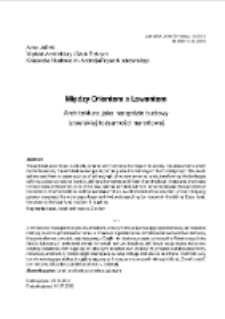- Wyszukaj w całym Repozytorium
- Piśmiennictwo i mapy
- Archeologia
- Baza Młynów
- Nauki przyrodnicze
Wyszukiwanie zaawansowane
Wyszukiwanie zaawansowane
Wyszukiwanie zaawansowane
Wyszukiwanie zaawansowane
Wyszukiwanie zaawansowane

Obiekt
Tytuł: Między Orientem a Lewantem : architektura jako narzędzie budowy izraelskiej tożsamości narodowej
Subtitle:
Journal of Urban Ethnology 13 (2015)
Publisher:
Instytut Archeologii i Etnologii PAN
Place of publishing:
Description:
Type of object:
Abstract:
The architecture of Israel is not only a mirror which reflects the image of its society; it is also a matrix which forms this society. The architecture and spatial planning were the mainstays of the Zionist project. The Jewish settlers used them to create a policy of fait accompli: they were annexing lands, transforming the landscape, defining a distinct national identity, defining themselves as different from the local inhabitants, the Arabs. In the process of the construction of the new, national architectural form, tensions between the supporters of the Semitic-Oriental tradition and the members of the Euro-Modernist school is evident, and an intriguing paradox is exposed: the more deeply Israeli architecture is searching for its roots in the biblical Eretz Israel, the closer to the local Arab tradition it is getting
References:
Arendt H. 2012, Pisma Żydowskie, przeł. Godyń M. i in., Biblioteka Kwartalnika Kronos, Warszawa
Hakim B. S. 1986, Arabic-Islamic Cities. Building and Planning Principles, KPI Limited, London, New York, Sydney and Henley
Harlap A. 1982, New Israeli Architecture, Fairleigh Dickinson University Press, Madison
Heinze-Greenberg I. 2001, Jestem wolnym budowniczym – Budowle w Palestynie, przeł. Kęsicka M., [w:] Stephan R. (red.), Erich Mendelson. Dynamika i funkcja, Muzeum Architektury we Wrocławiu, Wrocław, s. 182-209
Herzl T. 2006, Państwo Żydowskie. Próba nowoczesnego rozwiązania kwestii żydowskiej, przeł. Surzyn J., Wydawnictwo Austeria, Kraków
Kunda S. D., Oxman R. 2004, The Flight of the Camel: The Levant Fair of 1934 and the Creation of a Situated Modernism, [w:] Yacobi H. (ed.), Constructing a Sense of Place: Architecture and Zionist Discourse, Ashgate Publishing Ltd., London, s. 52-75
Nitzan-Shiftan A. 2009, On Concrete and Stone: Shifts and Conflicts in Israeli Architecture, TDSR Volume XXI number I/2009, s. 51-65, http://iaste.berkeley.edu/pdfs/21.1e-Fall09Nitzan-Shiftan.pdf, 15.10.2014
Rosenberg G. 2011, Kraj utracony. Moja historia Izraela, przeł. Haykowska M., Wydawnictwo Czarne, Wołowiec
Rotbard S. 2003, Wall and Tower, [w:] Segal R., Weizman E. (ed.), A Civilian Occupation: the Politics of Israeli Architecture, Verso, New York, s. 39-57
Relation:
Volume:
Start page:
End page:
Detailed Resource Type:
Format:
Resource Identifier:
oai:rcin.org.pl:60574 ; 1429-0618
Source:
IAiE PAN, call no. P 714 ; IAiE PAN, call no. P 1505 ; kliknij tutaj, żeby przejść
Language:
Rights:
Terms of use:
Copyright-protected material. May be used within the limits of statutory user freedoms
Digitizing institution:
Institute of Archaeology and Ethnology of the Polish Academy of Sciences
Original in:
Library of the Institute of Archaeology and Ethnology of the Polish Academy of Sciences
Access:
Kolekcje, do których przypisany jest obiekt:
- Digital Repository of Scientific Institutes > Partners' collections > Institute of Archeology and Ethnology PAS > Institute Publications
- Digital Repository of Scientific Institutes > Partners' collections > Institute of Archeology and Ethnology PAS > Institute Publications > Current Journals
- Digital Repository of Scientific Institutes > Literature > Journals/Articles
- Digital Repository of Scientific Institutes > Partners' collections > Institute of Archeology and Ethnology PAS > Institute Publications > Current Journals > Journal of Urban Ethnology
Data ostatniej modyfikacji:
11 kwi 2021
Data dodania obiektu:
2 gru 2016
Liczba pobrań / odtworzeń:
1331
Wszystkie dostępne wersje tego obiektu:
https://rcin.org.pl./publication/78959
Wyświetl opis w formacie RDF:
Wyświetl opis w formacie RDFa:
Wyświetl opis w formacie OAI-PMH:
| Nazwa wydania | Data |
|---|---|
| Jasiński, Artur, 2015, Między Orientem a Lewantem : architektura jako narzędzie budowy izraelskiej tożsamości narodowej | 11 kwi 2021 |
Obiekty Podobne
Zaremska, Hanna (1948– )

 INSTYTUT ARCHEOLOGII I ETNOLOGII POLSKIEJ AKADEMII NAUK
INSTYTUT ARCHEOLOGII I ETNOLOGII POLSKIEJ AKADEMII NAUK
 INSTYTUT BADAŃ LITERACKICH POLSKIEJ AKADEMII NAUK
INSTYTUT BADAŃ LITERACKICH POLSKIEJ AKADEMII NAUK
 INSTYTUT BADAWCZY LEŚNICTWA
INSTYTUT BADAWCZY LEŚNICTWA
 INSTYTUT BIOLOGII DOŚWIADCZALNEJ IM. MARCELEGO NENCKIEGO POLSKIEJ AKADEMII NAUK
INSTYTUT BIOLOGII DOŚWIADCZALNEJ IM. MARCELEGO NENCKIEGO POLSKIEJ AKADEMII NAUK
 INSTYTUT BIOLOGII SSAKÓW POLSKIEJ AKADEMII NAUK
INSTYTUT BIOLOGII SSAKÓW POLSKIEJ AKADEMII NAUK
 INSTYTUT CHEMII FIZYCZNEJ PAN
INSTYTUT CHEMII FIZYCZNEJ PAN
 INSTYTUT CHEMII ORGANICZNEJ PAN
INSTYTUT CHEMII ORGANICZNEJ PAN
 INSTYTUT FILOZOFII I SOCJOLOGII PAN
INSTYTUT FILOZOFII I SOCJOLOGII PAN
 INSTYTUT GEOGRAFII I PRZESTRZENNEGO ZAGOSPODAROWANIA PAN
INSTYTUT GEOGRAFII I PRZESTRZENNEGO ZAGOSPODAROWANIA PAN
 INSTYTUT HISTORII im. TADEUSZA MANTEUFFLA POLSKIEJ AKADEMII NAUK
INSTYTUT HISTORII im. TADEUSZA MANTEUFFLA POLSKIEJ AKADEMII NAUK
 INSTYTUT JĘZYKA POLSKIEGO POLSKIEJ AKADEMII NAUK
INSTYTUT JĘZYKA POLSKIEGO POLSKIEJ AKADEMII NAUK
 INSTYTUT MATEMATYCZNY PAN
INSTYTUT MATEMATYCZNY PAN
 INSTYTUT MEDYCYNY DOŚWIADCZALNEJ I KLINICZNEJ IM.MIROSŁAWA MOSSAKOWSKIEGO POLSKIEJ AKADEMII NAUK
INSTYTUT MEDYCYNY DOŚWIADCZALNEJ I KLINICZNEJ IM.MIROSŁAWA MOSSAKOWSKIEGO POLSKIEJ AKADEMII NAUK
 INSTYTUT PODSTAWOWYCH PROBLEMÓW TECHNIKI PAN
INSTYTUT PODSTAWOWYCH PROBLEMÓW TECHNIKI PAN
 INSTYTUT SLAWISTYKI PAN
INSTYTUT SLAWISTYKI PAN
 SIEĆ BADAWCZA ŁUKASIEWICZ - INSTYTUT TECHNOLOGII MATERIAŁÓW ELEKTRONICZNYCH
SIEĆ BADAWCZA ŁUKASIEWICZ - INSTYTUT TECHNOLOGII MATERIAŁÓW ELEKTRONICZNYCH
 MUZEUM I INSTYTUT ZOOLOGII POLSKIEJ AKADEMII NAUK
MUZEUM I INSTYTUT ZOOLOGII POLSKIEJ AKADEMII NAUK
 INSTYTUT BADAŃ SYSTEMOWYCH PAN
INSTYTUT BADAŃ SYSTEMOWYCH PAN
 INSTYTUT BOTANIKI IM. WŁADYSŁAWA SZAFERA POLSKIEJ AKADEMII NAUK
INSTYTUT BOTANIKI IM. WŁADYSŁAWA SZAFERA POLSKIEJ AKADEMII NAUK




































